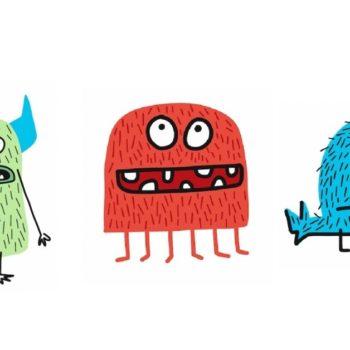Graffiti Wall: A Grief Activity for Kids
/ Kids and Teens : Eleanor Haley
We love the Graffiti Wall grief activity for kids; it's easy, fun, and kind of cool. Using paper, markers, and a few other materials, you will create a 'graffiti wall' in your home where children and family can draw or write down their feelings. This activity is super easy, and it's not nearly as messy as it sounds.
Who is this grief activity good for?
This activity is good for school-aged children, tweens, and younger teens. Try to engage reluctant older teens by placing the wall in a room with more privacy. You can also ask them to help set a good example for younger siblings by showing them 'how it's done'.
Why we like this activity?
We like this grief activity because it encourages children to express their emotions in a fun and accessible way. Also, it send the message that the adults in the home support open expression and value their feelings. Additionally, it gives children control over when and how they'll express their emotions and eliminates the pressure and time constraints of more structured activities. The entire family has access to the wall so children can tell their family members how they feel without saying a word. And parents can monitor the wall and check in with their children if they see something they think they should discuss.
What you need?
All necessary supplies can be inexpensively purchased at your local craft store, Target, or Walmart.
This is the minimum supply list:
- Strong tape
- A large piece of paper
- A few crayons or markers
This is exactly what we bought:
For our sample activity, we bought all of our supplies at Michaels Arts and Crafts. They cost about $25.
- Roll of white paper
- Graffiti patterned Duct Tape
- String
- Crayola Twistables Slick Stix
Grief Activity Set up:
1. Choose a wall in your home where you will set up the 'graffiti wall'. You will leave the wall up for a while so pick a space where it won't be in the way. You might want to ask your kids for input on where they would like the wall or give them a few options to choose from.
- Choose a more central wall if: You don't mind company seeing it, you want it to be prominent and easily accessible, you want to be able to easily monitor the activity.
- Choose a more secluded location if: You're concerned about the aesthetic, don't want company to see it, children verbalize the need for more privacy.
2. Create the wall:
- We used 4 sheets of paper cut from a large roll of paper. You could also use several large pieces of poster board or a large dry erase board. Whatever you use, make your wall as big as possible so you don't run out of room too quickly.
- Tape your paper to the wall. Duct tape held up our wall nicely and did not damage our (non-wallpapered) walls. Our local Michaels Arts and Crafts had a cool selection of patterned duct tape so we chose one with a graffiti design for a little added color.
3. Divide the wall in half:
- One side of the wall is for feelings more typically thought of as negative and the other side is for feelings typically thought of as positive. Think sad days and happy days.
- Label each side of the wall. I have a smaller child who can't read so we drew a happy face on one side and a sad face on the other. You could also label with words like 'Good Days' & 'Bad Days', 'I like...' & 'I do not like...', 'Good feelings' & 'Bad feelings'. You get the picture.
4. Fill a box with materials:
- If possible, keep a box with crayons and/or markers close by so kids can choose different colors to express different moods. We chose Crayola Twistables Slick Stix because they are bold and more exciting than markers. They are easy for little kids to write with and they wash easily off hard surfaces. Disclaimer: I did not test to see if they come out of fabric (i.e. clothing or carpet).
- Add tape to your box of materials or make a child-friendly adhesive easily accessible so children can tape photographs, magazine & newspaper clippings, and other items to the wall.
- If you don't want to keep a box of materials handy, an alternative is to tie a string to a crayon/marker and tape it to the wall. This way your kids will always have something to write with.
Writing on the Wall:
Explain the activity to all children in the house. It's important they know the following...
- Encourage participation, but share it's optional.
- The wall is for expressing their feelings. They can do this by writing words or drawing pictures. Let them know if they just feel like drawing (not about feelings) you will provide them with separate sheets of paper.
- The wall will be left up for a while and they can add to it whenever they like. For this reason, they don't need to fill it up right away.
- Prepare them that some days they will feel like drawing on the happy side, some days on the sad side, some days neither, and somedays both.
- The entire family can see and write on the wall, including adults. Unless your wall is 'For Children Only'.
- They are free to add photographs, newspaper clippings, pictures from magazines, or anything else that says something about them or reminds them of their loved one (in both good and bad ways).
- Taking your family into account, set any boundaries necessary to make the activity a success while trying to set as few rules as possible. Decide if you need to set rules about profanity or swear words. For Example: If my mother had attempted this activity with her children at least one of them (who shall remain nameless) would probably have made a mockery of the exercise. For that reason, she might have made a rule that went something like this. "I will be taking everything written on this wall seriously, as such we ask you to take the activity seriously. If you treat this activity like a joke you will be given a warning. If you continue to ruin the exercise for everyone else you will no longer be allowed to contribute".
Now, let them draw!!!
A few parting tips for the grown-ups:
- Get them started: Unless you made a 'No Grown-ups Allowed' rule, try writing a few things on the wall yourself to break the ice. Every once in a while add something to the wall. Children often follow the cues of adults when learning to express feelings and emotions.
- Don't hover and don't push. That being said, with younger children its a good idea to draw with them and talk about their picture as you go.
- With older, more independent children, talk about some of the things on the wall but you may not want to ask about everything. Follow their cues, if they don't seem interested in talking, don't push it. If they think you'll have a heart to heart about everything they draw, they may give up on it.
- Decide as a group when it's time to take the wall down and what you will do with it.
This activity is an adaptation of 'Graffiti Wall' published in the book 'Therapeutic Activities for Children and Teens Coping with Health Issues' by Robyn Hart and Judy Rollins.
For more children’s book and activity recommendations, check out the following articles:
- Grief Activity Books for Kids 3-9
- 64 Children’s Books About Death and Grief
- Exploring the Mixed-Up Emotions of Grief: Art Activities for Kids
- After a Suicide Death: An Activity Book for Grieving Kids
- A Thanksgiving Grief Activity for Kids
- Remembering Ornament: A Holiday Grief Activity for Kids & Teens

We invite you to share your experiences, questions, and resource suggestions with the WYG community in the discussion section below.
We wrote a book!
After writing online articles for What’s Your Grief
for over a decade, we finally wrote a tangible,
real-life book!
What’s Your Grief? Lists to Help you Through Any Loss is for people experiencing any type of loss. This book discusses some of the most common grief experiences and breaks down psychological concepts to help you understand your thoughts and emotions. It also shares useful coping tools, and helps the reader reflect on their unique relationship with grief and loss.
You can find What’s Your Grief? Lists to Help you Through Any Loss wherever you buy books:






Anne Woita April 17, 2015 at 9:14 am
I am associated with a non-profit arts organization in Lincoln, Nebraska called Hildegard Center for the Arts (a 501(c)3). Our organization does not have walls, physical or metaphorical, and our mission is to collaborate with existing organizations and agencies to Celebrate the Arts and Inspire Humanity.
As part of our theme of “Bridges” for our programming for the next three years, I am undertaking a project to work with artists, teachers and therapists to develop and formalize art lesson plans to be used for enrichment, growth and healing. We are developing the plans to be implemented by those who work with the elderly, Alzheimer’s patients, Autistic children and adults and those facing the challenges of Post Traumatic Stress Disorder (both children and adults–including our Veterans) as well as emotional, mental and physical challenges. We will be trying out the plans through pilot programs at places such as the VA Hospital, Retirement Communities, Alzheimer’s facilities and Child Behavior/Development/Trauma Centers before we eventually post the plans on our website (www.hildegardcenter.org). We’d like to also include articles by professionals and therapists and also include a forum for the exchange of ideas.It’s a pretty daunting task but we’re digging in!
Two of our Pilot Sites that works with Kids with behavioral issues or have experienced sexual trauma have asked us to come up with activities/lesson plans that will help children calm/focus themselves as well as deal with anger and grief. I came across your activity: “Graffiti Wall: A Grief Activity for Kids” and feel it could be tremendously beneficial for the kids as they work with their counselors and therapists. Could I have permission to re-post this activity on our website with proper citation and the recommendation that those who visit our site also peruse yours? It’s an outstanding resource and would make a perfect addition to our project.
We, at Hildegard, are excited about the possibilities our project generates. All plans and materials we are able to gather and post on-line will be free for downloading and use by anyone who could benefit from bringing the arts to their clients/patients. I am hoping you will be willing to “partner” with Hildegard Center in this way to bring the arts to a larger audience as we also shine a light on all the great work you’re doing.
I will look forward to hearing what you think! Anne Woita (402-890-2528)